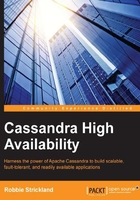
Preface
Cassandra is a fantastic data store and is certainly well suited as the foundation for a highly available system. In fact, it was built for such a purpose: to handle Facebook's messaging service. However, it hasn't always been so easy to use, with its early Thrift interface and unfamiliar data model causing many potential users to pause—and in many cases for a good reason.
Fortunately, Cassandra has matured substantially over the last few years. I used to advise people to use Cassandra only if nothing else would do the job because the learning curve for it was quite high. However, the introduction of newer features such as CQL and vnodes has changed the game entirely.
What once appeared complex and overly daunting now comes across as deceptively simple. A SQL-like interface masks the underlying data structure, whose familiarity can lure an unsuspecting new user into dangerous traps. The moral of this story is that it's not a relational database, and you still need to know what it's doing under the hood.
Imparting this knowledge is the core objective of this book. Each chapter attempts to demystify the inner workings of Cassandra so that you no longer have to work blindly against a black box data store. You will learn to configure, design, and build your system based on a fundamentally solid foundation.
The good news is that Cassandra makes the task of building massively scalable and incredibly reliable systems relatively straightforward, presuming you understand how to partner with it to achieve these goals.
Since you are reading this book, I presume you are either already using Cassandra or planning to do so, and that you're interested in building a highly available system on top of it. If so, I am confident that you will meet with success if you follow the principles and guidelines offered in the chapters that follow.